Building a Falco,
Part 2
![]()
Building a Falco,
|
|
by Stephan Wilkinson
This article appeared in the March 1988 issue of Pilot magazine in England.
"How's the airplane coming?" my friend asks. He too is a homebuilder, though he lives 3,000 miles away, in Los Angeles. I am sitting in rural New York, telephone in hand, staring out a window toward an elderly barn. Inside the barn is a half-finished Sequoia Falco aerobatic two-seater, a small spruce mosquito that has been abuilding for nearly three years now. Outside the barn, the second snowstorm of the season begins to build drifts. (Is the roof sagging? Will its old split-pole rafters, the bark of the 19th-century trees still in tatters upon them, last another winter? Is snow beginning to build on the barn floor in eddies and whispers wherever there's a chink in the rotting boards?)
"Aw, I'm sort of burned out on it right now," I tell him. "I haven't touched the thing in weeks."
"God, I can't bear to do that. I'd be afraid that if I ever stopped, I'd never start again." My friend, a serious homebuilder, is crafting his own awesomely complex original design intended for outlandish speeds, altitudes and distances. If his project is the nouvelle cuisine of homebuilding, mine is Shake n' Bake. "I set myself a certain amount of work to do every day," he says, "and I feel I have to do it no matter what."
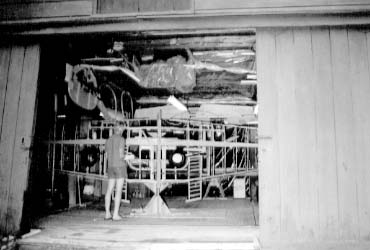
Perhaps that is for me the secret of enjoying airplane-building: don't take it seriously. The Falco must fit itself into my life, and if that means it must occasionally sleep in the barn, sawdusty and neglected, for weeks at a time, it's a far better fate than would be mine if I had to rearrange life to encompass what after all is only an airplane.
To have the Falco there, ready to be worked upon when I wish, out of sight and out of mind when I don't, is a delight. The studio in which I write-a chocolate-brown chunk on stilts, 12 feet on a side, one wall all glass-also frames the barn in its view. Often a paragraph goes nowhere until I have succumbed to that sight, put the writing aside in favor of gluing a rib, clamping a cornerblock, sanding a rough seam or drilling a fitting first. I come back to the keyboard renewed by 15 minutes of play.
When I was a boy, my father would delight in demonstrating a peculiar property of a domed passageway deep within Manhattan's Grand Central Station. On the special days when I'd be allowed to accompany him to the office, he'd stand facing one corner of that vaulted station chamber and, back to back, I would do the same diagonally across from him, perhaps 50 feet away. His whisper would carry clearly to my ears, slithering along the perfectly curved tiled ceiling while commuters trooped past and never heard it.
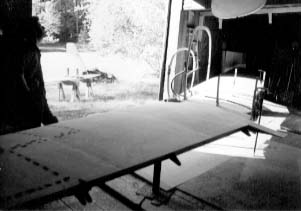
The Falco barn apparently contains something of the same architectural magic, though for no logical reason. The phenomenon was revealed by my mother-in-law, who with her conservative, reserved husband comes to visit us each summer for an extended stay. Grace and Irwin are wont to sit reading in our expansive living room, ceiling fan fluttering overhead, patio doors flung wide to the considerable lawn that lies between the house and the barn it faces while son-in-law pursues his deviant fascination with a plywood-covered structure that represents an investment that could easily have their daughter driving a Porsche.
"It's too bad Stephan hates working on that airplane so much," said Grace to my wife one day.
"Hates it? He loves it," Susan answered.
"Then why is he constantly cursing it, poor thing?"
From barn to house is perhaps 200 feet-a distance I had considered to be an ample buffer to allow me a construction technique known in our house as "shouting it into place." Other people trim, wheedle, cozen, slide or tap components together. I swear at them. Other people stop and reappraise or reapproach situations that frustrate them. I summon up the vilest curses to embarrass the bafflement into relenting. Other people sand, file and fit, then sand, file and fit some more. I voice the most unspeakable, anatomically impossible private terms as a cathartic substitute for repetitive effort. And somehow the open-doored barn was acting as a wretched sounding board focused, like that train-station tunnel of my youth, on a single spot. A spot where my in-laws sat to take their contemplative ease. How embarrassing.
Build a Falco and you learn at first hand that an airplane is a wing. A wing with seats atop it and primitive extensions to support engine and tail, but the wing is the heart of the matter. Appropriately, the Falco's wing spar is the single largest component of the aircraft-a tapered Brobdingnagian toothpick of spruce, bent elegantly in the middle and showing in every lamination, scarf joint and internal support (except for a solid centersection 8.5 inches deep and 4.25 thick, the spar is largely hollow) the craft of Falco wood-kits supplier Francis Dahlman.
From that spar proceeds the assembly of a trusswork of ribs and secondary spars that never fails to amuse those privileged to have seen the filmy ribs of production planes and of even such tough, externally braced designs as the Pitts. The Falco's wing is a phenomenally stout structure of thick, closely spaced ribs all bound together by a comparatively heavy plywood skin. If Dassault built business jets of wood, this is how they might do it.
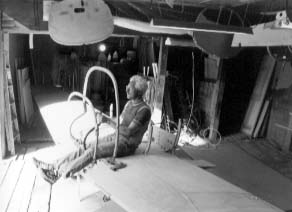
A few Falco builders have first made a fuselage and then a wing, fitting them together, fuselage frames nesting nicely against the spars to which they glue. It is a superficially logical procedure but a delicate one: the spaces between spars (there are three in all) in the completed wing must match to the millimeter the position of the completed frames (the circular rings that determine the fuselage cross section) to which they glue, for this is the airplane's Jesus joint-wing centersection clasping the cockpit area in, one hopes, a permanent embrace.
A more reassuring and ultimately far easier technique is to build the wing first, in a vertical jig, with the relevant fuselage frames an inextricable part of the structure from the outset. When the wing is complete and set horizontally upon temporary supports, you have the beginnings of a fuselage rising skeletally above it and can begin building the airplane's body fore and aft from that foundation.
What makes building the wing a tricky procedure is that it has a delicate twist from root to tip-a gentle, consistent rise of about half an inch along a span of some 10 feet. Simply gluing the ribs at right angles to the spar at their stations won't do. Instead, wing construction begins as a cat's-cradle of strings stretched to define the leading and trailing edges, and how accurately the minute measurements were made that locate the fixings of those strings becomes a question that will only be answered by flight. Have I built a 180-horsepower corkscrew, each wing warping through the air at a slightly different angle? Will I own a dog that trots along with its wing cocked a degree or two above the optimum?
The import of such questions is difficult to explain to the moderately curious, who ask questions but lose interest after learning that, "Oh, you're building a kit." (Left unsaid is, "I thought you said you were building an airplane, not just screwing together some parts.") Airplane homebuilding has become a matter of moderate interest in the general press hereabouts, since all its dimensions-dollars, people, number of aircraft-so greatly outweigh the equivalent statistics for what little remains of the lightplane industry. But this means the public has become aware largely of ultralights assembled with ordinary-household-tools technology and of what one friend calls "Tupperware airplanes"-composite homebuilts with all the style and grace of plastic kitchenware.
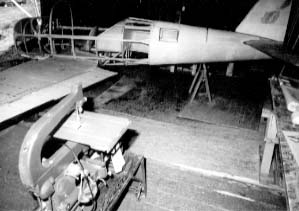
Interest in the Falco, however, draws interviewers from the Far East, and one Saturday, three small Japanese-writer, photographer and driver-and a statuesque gaijin interviewer arrive at our remote home. She-Consuelo, a six-plus-foot ex-tennis pro who charms us all immediately-does the actual taped interview, for the Falco is to be the subject of an article in a Japanese magazine intended for businessmen who want to learn English.
Subscribers get not only the magazine but a tape cassette of me pontificating about homebuilding. The Japanese seem baffled by my inability to remember how long I've been working on the airplane and my unwillingness to predict a completion date.
A more worrisome visitor was Sequoia Aircraft's Alfred Scott, the dear, obsessed, infinitely helpful man who is responsible for bringing the 1960s Frati Falco F.8L back to life as the much-improved 1980s Sequoia Falco. Scott had seen many a kit Falco under construction, and I imagined he would look upon the clumsiness of mine as an insult to his obsession. He approved, however, to my vast relief. Scott took pictures, seemed interested in some of the things I'd done and found fault only with my lumpy ailerons. Originally intended for fabric skinning, I had done mine in thin plywood, and the skin showed every rib-to-rib variation. Worse, despite what I'd thought was reasonable care, one was mounted a few millimeters out of line with its wing bay. I'd known it but needed the outside approbation to force me to relocate the hinge brackets-a considerable job, since it involves the shared flap-hinge brackets as well.
Still, one of the great delights of working with wood is the ease with which mistakes can be corrected-holes plugged and redrilled, shims glued in place where too much wood has been removed, surfaces built up with a few strips of thin plywood wherever needed.
Scott takes the Falco not only seriously but personally, and he is devastated when a newly completed kit Falco crashes and kills its builder and another pilot. The very first kit Falco to be completed had also crashed fatally, nearly two years earlier, which means something like 20 percent of the active Sequoia Falco fleet had destroyed itself and four people. A fatal flaw? Hardly, for both airplanes had stalled and crashed during desperate attempts to make deadstick landings after careless fuel exhaustion-the first airplane during an instrument approach, this one on takeoff. (In the more recent accident, the retired student-pilot builder and a young local pilot had landed the new Falco to refuel but found the FBO sold out. They'd guessed there was enough fuel remaining to try another airport. The engine proved them wrong on climb-out, and the builder's friend, in the left seat, apparently tried to turn back to the runway from an altitude of only 300 feet.)
If there is a "flaw," perhaps it's that the Falco is an airplane that by European standards is light and precise yet not untypical in its handling qualities. By docile, undemanding Beech/Cessna/Piper standards, however, it is sensitive, unstable, quirky. It has a stick. It stalls distinctly. It is entirely willing to spin. Whether Skyhawks or Cherokees in the same situations would have crashed as disastrously as did the Falcos, it's impossible to say.
Scott in no way avoids this reality. His builder's manual includes a remarkably complete chapter on cautious flight-testing, and he goes to great lengths to deter inexperienced builder-pilots from testing their own Falcos. He stands ready, in fact, to provide a Marine F-18 Hornet acceptance-test pilot friend and Falco builder to do the initial flight for any Falco builder so disposed. It is an option I may someday at least consider.
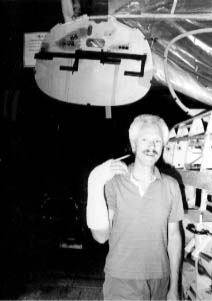
One summer, I returned to the barn with a broken arm acquired during a tramp through the Maine woods in search of Nungesser's and Coli's lost transatlantic biplane, l'Oiseau Blanc. (But that's another story-one that approaches its culmination as inexorably and surely as does the Falco, though I suspect the mystery of the two Frenchmen will be solved before I fly.) The injury was infuriating, for it was perfect homebuilding weather, ideal gluing temperature, lovely days to shape an airplane. Two weeks before my next appointment with the doc, I took my favorite Tyzack backsaw to the cast. Free again to bend and staple, cut and fit, glue and sand.
A salient moment is reached when my Falco's completed wing is removed from the jig that has held it vertical and is gently rotated onto jacks so that it sits normally. Huge, broad, expansive, it fills the barn like a wooden stealth bomber-hey, not a bad idea-and now the inevitable comment becomes, "Very nice, but how are you going to get it out of the barn?" My theory-supported by some casual exercises with a graph-paper plot of the barn floor and a scale planform of the Falco-is that if I can figure out how to build it, I can figure out how to get it out the one door, across half an acre of hilly lawn, onto a flatbed trailer, down a driveway long and steep enough to be impassable for parts of each winter, onto a death-trap divided highway...oh hell, I can always Sikorsky it out.
The Falco's fuselage is built around an enormous, temporary central beam of 2x4s and ordinary plywood with small crosspieces screwed to it at each fore-and-aft station. The crosspieces support the circular fuselage frames. The entire fuselage takes shape in no time, for there are only four main longerons (plus a few subsidiary sticks) that tie the whole thing together. Soon, I am able to perform the homebuilder's rite of passage: sitting in what will be the cockpit making airplane noises and wiggling the stick. My daughter's male playmates invariably add the sound of machine guns as they key the little red microphone button atop the stick. She, more pacific and less acculturated to what one is "supposed to do" with airplanes, spends her imaginary flight time wearing a headset and arguing with ATC.
Ideally, the 2x4 keel should stay in place until the entire fuselage is skinned, the crosspieces ensuring that nothing shifts or warps as the structure grows. Instead, I grow impatient with the great pipe-frame bedstead that supports the keel and tire of explaining to people that no, the big piece of household lumber will not be part of the finished airplane.
Having seen the assymmetry and ironmongry of unclothed Ferraris, I content myself with thinking that the original Falcos were also built by Italians, and they fly just fine. I skin the upper half of the tailcone to provide a stiffening spine, and the imprisoned beam is sawn in half and withdrawn to become firewood. The fuselage remains as sturdy as a tip lorry.
Despite my refusal (or inability) to pursue the kind of perfection that leads some homebuilders to cosmetically finish and perfect internal structures that will never see daylight, one of the continuing miracles of the Falco is how perfectly everything fits, even after construction reaches stages where no amount of drilling-and-filling or gluing of shims can correct a thing. The cockpit floor has been built and the instrument panel is bolted in place, for example, and the unyielding aluminum center pedestal slips into place between panel and floor firmly, tightly, perfectly.
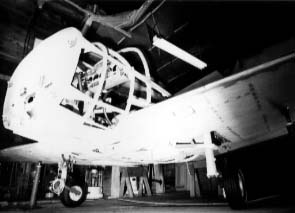
From firewall aft to the cockpit rear wall, a train of preformed fiberglass components that nest one into the next-nosewheel-bay cover, trim-control cover, the entire between-the-seats central console and gear-motor cover-fit as perfectly as they would have in a factory.
The seats on their sliding tracks-my Christmas gift from my wife-fit into place with literally the one-millimeter thickness of the interior cockpit skin to spare.
I swing the landing gear up into its wells, lying on my back wondering how long it will take for my plight to be discovered if the airplane falls off its jacks, and everything nests like a hat in its box, just as it was intended to. Sometimes, I amaze myself.
Surprisingly, the only thing that doesn't fit perfectly is the rather expensive engine-mount framework (just over $1,000, including Lord mounts). It sits slightly spraddle-legged on the front face of frame one. If I align any one of the tube-steel framework's four mounting brackets with properly premarked bolt holes to be drilled through that bulkhead, the centroid of the four Lord mounts isn't at the airplane's centerline. If I align a plumb-bob from that centroid with the bulkhead centerpoint, each of the four mounting brackets is slightly askew. Scott later confides that kit components produced for Sequoia by subcontractors accustomed to common machine-shop standards were invariably faultless. The engine mounts, ordered from a highly regarded general-aviation specialist, showed the lowest quality of workmanship that Sequoia would come to accept. In fact, Scott has since found a new and assumedly better engine-mount supplier.
My Falco's engine will not be the standard 160-hp Lycoming but the maximum-allowable 180. The 12.5-percent greater horsepower will gain me perhaps only four percent more cruise-probably not even that, since I'll most likely fly it at a comfortable reduced-power setting-but I'll be able to climb faster and fly higher. Strong climb and the highest possible ceiling are so much more useful for weather flying than are a few knots more speed, and I find the most fortuitous flight levels to be around 16,000 feet-relatively unpopulated, well above the highest haze layer and often affording a much better view of weather. I am scared of ice, terrified of embedded cells. A bonus is that a new prop for an IO-360 is some $1,200 less expensive than is an IO-320 propeller.
I spend hours, drive miles from metal fabricator to machine shop to construction-supply house, searching for stainless steel for the firewall. Fortunately, I don't find it, for somebody eventually points out that I am asking for 0.20-inch steel plate, a fifth of an inch thick, rather than .020-inch sheetmetal. Frankly, the firewall seems an oxymoron on a Falco, for the nosewheel bay forms a neat blast tube into the cockpit, capped only by a fiberglass cover. Fireproof the fiberglass with a stainless-steel insert? Why bother? Wherever the flames go, they eventually come to a formation of flying firewood.
As winter clutches upstate New York, Falco-building pauses awhile. Aerolite glue needs a temperature of 15°C. or more to properly cure. I've been able to attain it during the late autumn with the help of a kerosene stove, heat lamps and a cocoon of plastic sheeting, but if that continues, I'm sure to torch the Falco, firewall or not. (My homeowner's insurance is delighted to cover a cedar-shingled house full of woodstoves. They see no problems insuring an estate that only the most resourceful fire engines could reach in the wintertime. They're happy to guarantee me against a society of litigious callers begging to plummet from icy porches or be beaned by a forest-ful of rotten tree limbs. They worry not a whit about insuring an aging barn surrounded by topheavy trees. But there is one very specific exclusion: an airplane inside that barn.)
What's fun is that what once looked like misguided cabinetry now is unmistakeably an airplane, and first-time viewers are easily awed when I theatrically trundle open the barn doors. What's also fun is that I have outpaced the builder's manual. Now I'm chopping and gluing and bending on my own, doing what's necessary in ways that have finally become second nature. No longer am I a neophyte terrified to cut a piece of plywood without reading the step-by-step directions through three times, I'm a confident initiate with a bunch of well-thumbed plans.
Not that there isn't ample material to guide the builder, 15 Sequoia Falcos having already been completed, but Scott continually finicks and tunes his builder's manual and is only now getting to the chapters covering skinning and detailing of the fuselage. Is it worth the wait? Expensive as the Falco kit is, builders are getting an unspeakable bargain in terms of Scott-hours per airplane. A friend, an industrial-management consultant accustomed to dealing with nuclear powerplant installations and the like, looks at my Falco blueprints and says he's never seen any as clean yet detailed. One of my brothers, 20 years a Harvard-trained architect, says he can't draw as well (Scott is a self-taught draftsman). Furthermore, he says, his own design firm would lose money if it charged a client only $400 for the same quantity of blueprints and drawings.
When spring comes, I'll finish skinning the forward half of the fuselage-after remembering to install the two fuselage fuel tanks, one hopes-and will mount the sliding canopy. Then the airframe will be complete, standing on its own gear, and I will begin to determine the validity of the First Law of Homebuilding, "Firewall forward is half the work."
To this moment, my investment in the airplane totals $34,722.31, about $28,000 of it for kits and plans, the rest for materials (glue, varnish, plywood, sandpaper) and tools I didn't already own (air compressor, pneumatic staple gun, router bits, more clamps than I've ever seen outside a hardware store). I still have some $10,100 in Falco kits to buy, plus an engine and avionics. Such an expenditure for the pieces alone of a two-seat wooden airplane of doubtful resale value cannot be rationalized.
One U.S. builder doesn't agree and is currently asking $150,000 for his admittedly outstanding, superfast, Ferrari-red kit-built Falco and has even consigned it to a dealer for resale, but I think the man is daft, joking or trying to start a Falco tulipmania. True, there has never been anything like the Sequoia Falco on the used-plane market, but nearly new Christen Eagles, another excellent kit-built design, generally sell for the value of the kit components at best. And a builder's liability when reselling a homemade airplane can best be protected, lawyers tell me, by neither making nor even implying the tiniest claim touting the airplane's condition, worthiness, performance, safety or suitability as anything other than a sump for the buyer's money. I doubt that a 160-hp airplane can be sold for the price of a nice house as is, where is, take it or leave it.
But I have decided that I needn't bother rationalizing my foolishness, for the project is priceless in the challenge and pleasure it affords. Nor is it entirely selfish. Said my wife recently, "You know, even if you turned that thing into firewood when you were finished, it would all have been worth it: our daughter is growing up realizing what enormous possibilities exist-making an airplane, things like that-and some people never get a chance to see that."
And who knows what pointless, expensive, unhealthy or even immoral hobbies I would pursue were it not for the Falco in the barn?